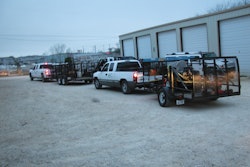Equipment pickup and deliveries are part of most any dealership’s service offering. The cost financially and time-wise can be damaging to the bottom line. Careful organization of routes and equipment, as well as charging service fees, are a few ways dealers can reduce cost while still providing the helpful service.
On the Trailer and Road
An essential part of LEAN transportation is organization. Organizing routes and equipment in the most efficient manner can save time and money. “We group our deliveries according to area,” explains Frank Fletcher of Fletcher’s Sales & Service in Greensburg, PA. “We try to organize the route so we can pick up and deliver several on the same trip.”
Dealers can plan routes on their own, or get help from software programs. “I have used Microsoft Streets and Trips,” says Scott Price of Fisher Implement Co. in Harrisburg, OR. “You can upload an Excel file with addresses, and then the program can optimize your route. You can also upload your entire customer list into streets and trips and it can show you other customers along your route so you can make some cold calls along the way.” The equipment on the trailer should be organized according to the order of deliveries to save time with ease of loading and unloading.
Scheduling the driver is as important as scheduling and routing the drive itself. “We set up a Microsoft Outlook account for our delivery driver, and when we schedule the deliveries, we add the delivery to his outlook calendar and block out an estimated amount of time that we believe the delivery will take,” says Price. “This ensures that we get as many deliveries scheduled on any particular day as we can.”
The driver himself can also play an important role in cost savings. Having a lower-paid employee do deliveries saves on paid wages and keeps the higher-paid employees like technicians in the shop where their work is more profitable. “The least-paid employee is the best one to have doing deliveries,” agrees Gary Nichols of Nichols Equipment Inc. in Jacksonville, FL. “But that’s not always who goes. Quite often, it ends up being a technician. If he’s gone for an hour or two, I’m losing $150 worth of billable time.”
While a lower-paid employee is more often than not the ideal employee to handle equipment pickup and deliveries, there are cases where a higher-paid, more knowledgeable employee may be best suited for the job. “Rarely does a situation come up that warrants having anyone else make the deliveries, but those cases can happen,” shares Price. “If a customer has a unique situation or the machine was a ‘problem child’, we may elect to have someone else deliver the machine, such as a salesman, service manager or technician. We do this to preserve the relationship with the customer.”
Recovering What LEAN Doesn’t
Carefully planning routes and organizing equipment, as well as properly delegating delivery responsibilities, can go a long way to save time and money. However, not all cost can be eliminated by running efficiently. To recover some of the additional costs, dealers can implement service fees and make smart choices in fleet and travel tools.
Many dealers have implemented service fees for equipment pickup and delivery. Rates vary by dealers, some being a flat rate and others depending on the distance traveled. The best way to decide on an appropriate fee is to evaluate the cost of delivery. “You must know your costs to operate your delivery services,” says Joe Hines of Hines Equipment in Cresson, PA. “It’s the best way to evaluate fees.”
Once overhead costs have been realized, a fee can be decided. In implementing the service fee, dealers should explain the costs to customers desiring pickup and delivery. “There are a lot of hidden expenses in pickup and delivery,” says Nichols. “I tell the customer about all of the expenses involved when I explain the fee. Some of them understand while others will find their own truck or trailer to use.”
Properly maintaining delivery vehicles can reduce costs and avoid additional costs. “The most important thing is to make sure the delivery schedule is optimized for maximum productivity, but you also need to make sure you have a well-maintained, reliable vehicle for hauling,” says Price. “A poorly maintained vehicle will get worse fuel economy, and most likely will break down when you need it on the road.”
Utilizing more cost-effective vehicles can be another way to recover costs. “We operate new trucks that are more efficient,” says Fletcher. “The rollback body is wider for loading and unloading, and the aluminum is lighter for better fuel efficiency.”
Benefits Outweigh Costs
While service fees, efficient routing and more efficient vehicles can help mitigate transportation costs, pickup and delivery could still prove to be a money-losing endeavor. “When I figure the cost of everything that goes into pickup and delivery, I can’t charge enough to recoup my money,” says Nichols. “As a result, we used to deliver to a wider range, but we now refuse delivery more often.”
Providing the service may be costly, but many dealers argue that pickup and delivery should always be a part of the service offering. Many dealers agree that it’s important to control costs, but not if it means depriving the customer of quality service.
“Pickup and delivery is a must,” says Fletcher. “We offer the total package. You must do it all to get and keep the customers.”
As an added bonus, pickup and delivery gets you that added face time with the customer, which is necessary for building the relationship. “Customer satisfaction can be simply distilled down to building a trusting relationship with the customer,” argues Price. “Every opportunity you have as a dealer to build on that relationship, you had better do your best.”




















